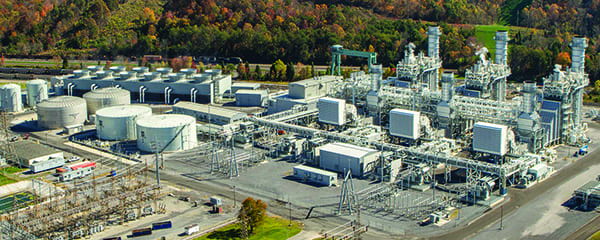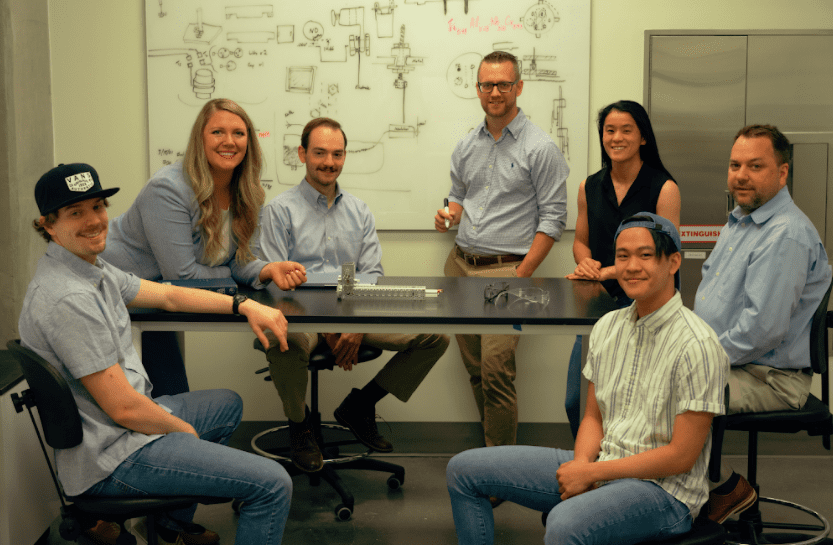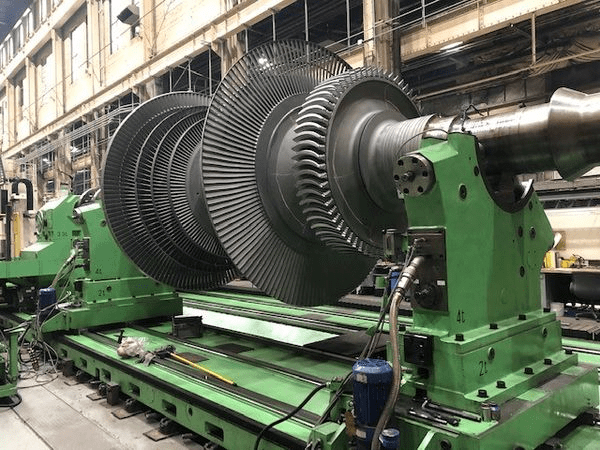TVA Power Plant Supplies Carbon from Flue Gas for Beneficial Use

A power plant in Tennessee is the site of a project using carbon dioxide (CO2) to help manufacture carbon nanotubes (CNTs), which can be used in a variety of products from wind turbine blades to cellphone batteries to lightweight bicycle frames.
SkyNano Technologies, a Knoxville, Tennessee-based developer of a manufacturing process to produce carbon-based nanomaterials using CO2 and electricity, recently announced its first-ever output of CNTs from flue gas at the Tennessee Valley Authority's (TVA's) John Sevier Combined Cycle Plant near Rogersville. The 871-MW Sevier plant began operation in 2012 and was named a POWER Top Plant award winner that same year.
Carbon nanotubes are small-about 1/100,000 the size of a human hair, and not visible under a traditional microscope-but they are very strong, flexible, and lightweight. The tubes have a hexagonal pattern such as that on a soccer ball. CNTs have many uses, including in computer chips and electronics, and in medicine among other industries. They have unique electrical properties, and are efficient conductors of heat.
 The John Sevier Combined Cycle Plant in Tennessee is home to a project that captures flue gas and uses it to create useful carbon nanotubes. Courtesy: Tennessee Valley AuthorityBreakthrough Technology
The John Sevier Combined Cycle Plant in Tennessee is home to a project that captures flue gas and uses it to create useful carbon nanotubes. Courtesy: Tennessee Valley AuthorityBreakthrough TechnologyCreating nanotubes from CO2 emitted by a power plant has been considered a breakthrough in the use of carbon for beneficial purposes. Researchers have said creating CNTs would lead to development of a host of scalable technologies for using CO2 from power plants worldwide to produce valuable products.
SkyNano's demonstration is a very important step in helping utilities meet decarbonization goals in the near-term, as we work towards bringing a higher portion of renewables and low-carbon energy generation online," said Anna Douglas, CEO and co-founder of SkyNano. Douglas told POWER, Utilities across the globe have fossil assets that are unlikely to be decommissioned before their end of lifetime, so SkyNano's process demonstrates an important solution to decarbonization in the near-term."
 Anna Douglas, second from left, and her team at SkyNano Technologies has plans to to continue engineering the scale-up of our technology" for several applications, she said. Courtesy: SkyNano Technologies
Anna Douglas, second from left, and her team at SkyNano Technologies has plans to to continue engineering the scale-up of our technology" for several applications, she said. Courtesy: SkyNano TechnologiesDouglas said the project at the Sevier plant is best characterized as the first practical application of the technology to capture CO2 from a natural gas power plant and transform that CO2 into carbon nanotubes. In fact, to our knowledge, this is the first practical application of any known technology to produce a marketable product from flue gas-derived CO2."
SkyNano's nanotubes are made by piping CO2 from a smokestack into a lithium salt reactor, and then spinning it into nanotubes. The company for now is producing small amounts of research-grade nanotubes for specific clients, while looking to increase production to serve commercial clients in the coming years. Douglas described the process as turning pollution into a useful and environmentally safe material for use in a range of products, including tires and batteries. She said it presents an immediate route forward" in the push for decarbonization.
SkyNano in a news release said that manufacturers normally synthesize nanotubes from hydrocarbons in an emissions-heavy process, so producing them through the transformation and utilization of CO2 from power generation is a major technological breakthrough that opens the door to uses of power plant emissions that can help decarbonize the grid even while keeping natural gas generation online."
Researchers at the Massachusetts Institute of Technology and elsewhere have been studying CNTs, in part to learn about new applications for carbon as an energy source. A power plant in Alberta, Canada recently announced it will implement carbon capture technology as part of a project that includes production of CNTs.
Valuable, High-Quality Materials'SkyNano is setting the standard worldwide for carbon capture and utilization," said Douglas. We proved power plant flue gas emissions can be captured and turned into valuable, high-quality materials. The next step is to scale this approach so we can help utilities convert flue gas into valuable carbon nanotubes that can then be used by battery and tire manufacturers and even inks and coatings. This demonstration is one of the first of its kind, showing the ability to make a marketable product from real-life power plant flue gas."
 TVA's John Sevier Combined Cycle Plant in Tennessee consists of three trains, each with a GE 7FA.04 gas turbine/generator (shown) and a Nooter/Eriksen heat recovery steam generator (HRSG). Each HRSG is equipped with natural gas-fired supplemental duct firing. The steam generated from the HRSGs provides steam to one Toshiba steam turbine/generator. Courtesy: TVA
TVA's John Sevier Combined Cycle Plant in Tennessee consists of three trains, each with a GE 7FA.04 gas turbine/generator (shown) and a Nooter/Eriksen heat recovery steam generator (HRSG). Each HRSG is equipped with natural gas-fired supplemental duct firing. The steam generated from the HRSGs provides steam to one Toshiba steam turbine/generator. Courtesy: TVAThe SkyNano project is part of a three-year, $2.5 million federally funded program to help bring new carbon-utilization technologies to scale. The U.S. Dept. of Energy's Office of Fossil Energy and Carbon Management in 2020 chose SkyNano to demonstrate the ability to utilize flue gas, in this case provided by TVA, to produce carbon nanotubes.
Whereas the cost of the process is proprietary, the cost is suitable to support market entry of our CO2-derived carbon nanotubes, at scale, at a price point one-third of today's market rate for carbon nanotubes," Douglas said. This economic picture enables SkyNano's free-market solution to carbon pollution, which relies on the value of the end product [carbon nanotubes] to make an economic case, rather than the value of carbon removal credits. The low-cost nature of our process is a function of the high efficiency of electrochemistry and the scalability of an ambient pressure system."
Carbon nanotubes are increasingly used in electronics, power cables, batteries and other products," said Dr. Joe Hoagland, vice president of TVA Innovation & Research, noting the utility is pleased to collaborate with SkyNano on the project. This is a technology that can capture and remove carbon in a productive manner."
History of CNTsResearchers in the former Soviet Union in 1952 said they had created filaments out of carbon, the first known instance of CNT production. Interest in the technology was subdued until 1991, when Sumio Ijima, a Japanese scientist, detailed the structure of CNTs and outlined a process for producing them on a large scale.
Global production of CNTs ramped up in earnest about 15 years later, with output of about 3,000 metric tons per year at present. Market growth has been curtailed, though, due to prices for CNTs that start at about $100 per kilogram, and by a production process with high energy costs and toxic byproducts.
SkyNano said its manufacturing process is cleaner, and needs less energy than the traditional chemical vapor deposition" method for creating CNTs. The company told POWER it uses an electrochemical process requiring less energy, with the ability to suck carbon out of harmful airborne CO2. Douglas characterized her company's process as being far more efficient that traditional gas phase synthesis.
SkyNano's process relies on a chemical absorption of CO2 via a metal oxide to form a carbonate molecule, then electrochemical decomposition of that carbonate to form elemental carbon and oxygen, and the initial metal oxide, which regenerates the carbonate molecule by uptaking another CO2," said Douglas. Overall, the net inputs are CO2 and electricity, with the net outputs being carbon nanotubes and oxygen."
Douglas said she developed the process as part of her Ph.D dissertation at Vanderbilt University. She was a member of the first class of Oak Ridge National Laboratory's Innovation Crossroads two-year entrepreneurial fellowship program in 2017.
There are no immediate plans to use this process on site at any other power plants, but SkyNano remains open to partnerships with power plants and other heavy industry emitters [chemical production, cement and steel production, etc.] looking to decarbonize their operations," Douglas said. SkyNano's immediate technical plans are to continue engineering the scale-up of our technology, as well as finding and demonstrating early applications for our CO2-derived carbon nanotubes." Douglas said those applications include batteries, advanced tires, building materials, sustainable composites, coatings, and more.
-Darrell Proctor is a senior associate editor for POWER (@POWERmagazine).
The post TVA Power Plant Supplies Carbon from Flue Gas for Beneficial Use appeared first on POWER Magazine.